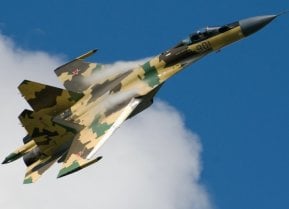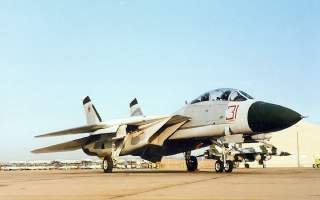From America with Missiles: Why Iran Loves Its F-14 Tomcats
Five decades in, Iran’s F-14s are only getting better and better. And more and more important to the Persian state’s defense.
“Shah views with bitter scorn corrupt practices of agents for U.S. companies and ineffective [U.S. government] efforts to deal with problem,” the embassy reported back to Washington in January 1976. The shah was so angry that he threatened to halt payments to Grumman. Washington reminded Tehran that failure to pay would amount to breach of contract.
“The dispute over agents fees was poisoning U.S.-Iranian relations,” American diplomats in Tehran warned. Amid the diplomatic tension, Tehran put its Tomcats to good use performing the mission for which Iran originally wanted them — deterring the Soviet Union’s MiG-25 spy planes. In August 1977, Iranian F-14 crews shot down a BQM-34E target drone flying at 50,000 feet. “The Soviets took the hint and Foxbat over flights promptly ended,” Iranian air force major Farhad Nassirkhani wrote.
Tehran’s spat with Grumman continued, but a year and a half later the Islamic Revolution intervened and rendered the issue moot. Revolutionaries took the streets. Violence broke out. On Jan. 16, 1979, the shah fled.
Twenty-seven of Iran’s freshly-minted F-14 fliers fled, too. On their own way out of the country, American technicians working for Hughes, the company that manufactured the Phoenix missile, sabotaged 16 of the deadly missiles — or tried to, at least. Engineers loyal to the ayatollah eventually repaired the damaged munitions.
Agents of Iran’s new Islamic regime suspected the remaining F-14 crews of harboring pro-shah and pro-American sentiments. Police arrested at least one F-14 pilot at gunpoint at his home, finally releasing him months later when the regime realized it actually needed trained aircrews if it ever hoped to make use of all those brand-new F-14s lined up on the tarmac at Khatami air base.
By September 1980, Iran and Iraq were at war. Baghdad’s own MiG-25 fighters and recon planes could dash into Iranian airspace unmolested by Tehran’s much slower and lower-flying F-4 and F-5 fighters. Over the course of the eight-year war, MiG-25s shot down more than a dozen Iranian aircraft, including a priceless EC-130 electronic warfare plane. Iraqi pilot Col. Mohommed Rayyan alone claimed eight kills in his MiG-25.
Only the F-14 could challenge the MiG-25.
When war broke out, just 77 Tomcats were left — two had crashed. With crews and maintainers scattered and Tehran cut off from Grumman, Hughes and the U.S. Air Force and Navy, most of the Iranian F-14s were inoperable. The ayatollah’s air force managed to assemble 60 loyal pilots and 24 back-seat radar operators. By stripping parts from grounded Tomcats, technicians were able to get a dozen F-14s in fighting shape.
They immediately flew into action. At first, the Tomcats acted as early-warning and battle-management platforms while less sophisticated planes did the actual fighting. “The planes have not been used in combat,” The New York Times reported in December 1981. “Rather they have stood off from the battle and been used as control aircraft, with their advanced radar and electronics guiding other planes to their targets or warning the pilots of Iraqi aircraft attacks.”
The fighting escalated and drew the F-14s into battle. In eight years of combat, Iran’s Tomcat crews claimed some 200 aerial victories against Iraqi planes, 64 of which the Iranian air force was able to confirm. One F-14 pilot named Jalil Zandi reportedly claimed a staggering 11 air-to-air victories, making him by far Iran’s deadliest fighter pilot of the war.
“The Iraqi high command had ordered all its pilots not to engage with F-14 and do not get close if [an] F-14 is known to be operating in the area,” Nassirkhani wrote. “Usually the presence of Tomcats was enough to scare the enemy and send the Iraqi fighters back.”
At first, the F-14s were armed only with their internal 20-millimeter cannons and the long-range Phoenix missiles. American contractors had not had time to integrate medium-range Sparrow and short-range Sidewinder missiles.
Normal tactics called for F-14 crews to fire Phoenixes at their targets from a hundred miles away or farther, but with no alternative armament Iranian aviators relied on the heavy AIM-54s for close-in fighting, as well — once even hitting an Iraqi plane from just 12 miles away, according to Iranian reporter Babak Taghvaee.
Eight F-14s fell in combat during the war with Iraq — one accidentally shot down by an Iranian F-4; three struck by Baghdad’s Mirage F.1 fighters; one hit by an Iraqi MiG-21; and two falling victim to unknown attackers.
The eighth Tomcat that Tehran lost during the Iran-Iraq war reportedly wound up in Iraq when its crew defected. Taghvaee claimed that U.S. Special Operations Forces infiltrated “deep inside Iraqi territory” in order to destroy the abandoned F-14 and “prevent it falling into Soviet hands.”
Iranian Tomcats intercepted Iraqi MiG-25s on several occasions. But only one Iranian flier succeeded in downing any of the Mach-3 MiGs. In September 1982 and again in December, Shahram Rostani struck MiG-25s with Phoenix missiles.
Combat ops were hard on Iran’s F-14 force. A lack of spare parts compounded the maintenance woes. After the revolution, the United States had frozen Iranian assets, embargoed Iranian trade and imposed other economic sanctions. The United Nations and many U.S. allies followed suit, cutting off Tehran from global supply chains.
In 1981 an Iranian trade agent wrote to the London office of F-14-builder Grumman asking to acquire parts for Iran’s Tomcats. Citing the new sanctions, Washington declined to grant Grumman a license to sell the components. “It is the present policy of the United States government not to permit Grumman or any other defense contractor to obtain a license to provide Iran with these materials,” the Navy told The New York Times.
By 1984, just 15 or so of the twin-engine fighters were flightworthy, according to Nassirkhani. Technicians kept the 15 jets in good repair mainly by taking parts from the roughly 50 F-14s that couldn’t fly.
Starting in 1981, Iranian Aircraft Industries began performing overhauls and upgrades on the F-14s as part of the Tehran’s effort to make the country militarily self-sufficient. The upgrades finally added Sparrow and Sidewinder missiles to the Tomcats. The self-sufficiency program had help from Iranian agents working abroad — and at great risk to themselves — to divert spare parts for the F-14s and other weapon systems.
America begrudgingly helped, too — albeit briefly. In negotiating to free American hostages that an Iran-backed militant group was holding in Lebanon, the administration of Pres. Ronald Reagan agreed to transfer to Tehran badly-needed military equipment, reportedly including Phoenix missiles and bomb racks. Iranian engineers added the bomb racks to four of the F-14s as early as 1985, transforming the Tomcats into heavy ground-attack planes. Years later, the U.S. Navy would modify its own F-14s in the same way.
Rostani flew the “Bombcat’s” first ground-attack mission in 1985, targeting an Iraqi field headquarters … but missing. Frustrated technicians boosted the Bombcat’s weapons load-out with a whopping, custom-made 7,000-pound bomb — one of the biggest freefall munitions ever. As Iranian commander-in-chief Gen. Abbas Babaei observed from near the front line, an F-14 lobbed the massive bomb.
The estimated time on target passed … but nothing happened. Babaei was getting ready to return to his jeep when a powerful blast shook the ground. The bomb had missed, but its psychological effect on Iraqi troops was surely profound.
By the war’s end in 1988, 34 of the 68 surviving F-14s were airworthy. But just two of the Persian Tomcats had working radars. And Iran had expended all of its original consignment of Phoenixes. More Phoenixes reportedly arrived as part of the hostages-for-arms deal with the United States, and in the post-war years Iranian Aircraft Industries experimented with “new” weaponry for the F-14 — including modified Hawk surface-to-air missiles that the shah had bought from the United States as well as Soviet-supplied R-73 missiles.
The experiments added flexibility to the F-14 force, but it was the spare parts that kept the Tomcats in working condition — and the Iranian air force quickly burned through the spares it obtained from the hostage deal. Tehran established self-sufficiency programs — not just in the air force, but across the nation’s economy — in an effort to satisfy material needs that foreign companies had once met.
In many sectors, the self-sufficiency initiative worked. Besides producing all its own oil, Iran has declared itself autonomous in agriculture, steel production, electricity generation and civil aviation. “Well before the advent of abundant oil wealth, Iranians have tended to see their country as a unique nation amply endowed with natural resources that could take care of itself without outside assistance,” said Rudi Matthee, a history professor at the University of Delaware.
But Iranian companies struggled to produce all the specialized parts that the Tomcat requires. In the late 1990s, the air force considered simply buying new planes to replace the F-14s, but China was the only country that would sell fighters to Iran. In 1997 and 1998, Iranian pilots evaluated China’s F-8 … and rejected it. Even deprived of spares and mostly grounded, the F-14s were superior to the Chinese planes in the eyes of Iran’s air force.
Tehran turned to the black market, paying huge sums to shady middlemen to sneak F-14 parts into Iran. American authorities became aware of the illicit trade as early as 1998. In March of that year, federal agents arrested Iranian-born Parviz Lavi at his home in Long Island, charging him with violating U.S. export law by attempting to buy up spare parts for the F-14’s TF-30 engine and ship them to Iran via The Netherlands. Lavi got five years in prison plus a $125,000 fine.


